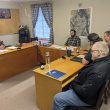Linn County has an opportunity – and a challenge.
After Gov. Kate Brown’s announcement on Oct. 30 that she was opening the door, slightly, to get students back in school, we’ve had some record spikes, including in Linn County, of COVID-19 cases.
Indeed, across Oregon, 130,000 students were immediately allowed to return to school in person following the governor’s press conference, in which she announced she was lowering the COVID metrics that effectively kept most of Oregon’s kids at home.
While we may hear local residents express doubts regarding just about every facet of the situation we find ourselves in, or wonder about the veracity of the numbers, there’s no question that we’re a sicker population now than we were a month ago.
The cap the governor set two weeks ago is 129 new COVID cases in the county per 100,000 residents.
And that presents a challenge: How can we get these kids back to school?
As of Thursday, Nov. 12, Linn County had had 191 new cases of COVID in the previous 14 days: A case rate of 147.2 per 100,000.
Lebanon alone had a record-breaking 40 new cases in the week ending Nov. 12, which brought its total case count to 269 cases since the beginning of the pandemic.
Thankfully, Linn County remains below the 200 per capita mark, so the pause the governor imposed on other counties on Nov. 6 hasn’t been implemented here yet, though the other nine counties are all under those new restrictions.
They involve additional restrictions on businesses: Restaurants in the impacted counties will need to reduce their indoor seating, and indoor recreational activities are limited to 50 people, including in gyms.
Back to the pressing question: What can we do, what will we do for our kids?
There’s no question that some of the children in our midst would benefit from attending a real brick-and-mortar school.
They need to be in a familiar and effective school setting, in person, to develop socially, emotionally and academically.
If a child doesn’t have siblings, school can be a very effective alternative to teach them how to work with peers, communicate and get along.
Experts who are involved with these kids tell us that they are getting depressed, spending all day staring at screens, and the youngest children, who are still learning how to read, face precipitous challenges in developing the skills they need for future academic success by using an online platform they may struggle to interpret.
What’s more, as the governor said, child abuse reporting is down significantly, as children no longer have contact with mandatory reporters who can help protect them. This, at the same time as domestic violence is on the rise.
It would be logical to assume that child abuse is climbing similarly, an invisible pandemic hidden from view behind the rising and falling waves of coronavirus.
For so many reasons, children need to return to school, and we are tantalizingly close in this county.
If we can drop our transmission rate in the next few weeks, it would be reasonable to assume we could have students back in school by the end of the month.
It will take a concerted effort and here’s the hard part: We have to do it. The school district can’t change the numbers for us. It’s on us.
Those of us who are COVID-critical may not want to wear masks or socially distance, but that may be what it’s going to take to help us make sure the numbers get cut enough to get kids back in school.
It may take a collective effort to help the most vulnerable, our youngest children, get the education they need to succeed.
What’s likely going to be required is better adherence to the guidelines we’ve been hearing for months now: Wash your hands, wear a mask and stay 6 feet apart when you’re near someone you don’t live with.
Scientists say it takes just 15 minutes of interaction within 6 feet of a COVID-positive person to contract the disease. That includes co-workers, friends and family we decide to visit.
It’s very difficult to say no to our friends, to refuse to engage, to pare down our Thanksgiving plans. We’re all sick of this pandemic and the response that’s been called for, and we know public officials are sick of it too.
This has been a hard year, full of sacrifice for all of us, but we have a choice in what we sacrifice: our social lives and uncovered faces, or what we are willing to forfeit to help preserve the lives of our elderly and the education of our youth.
We think it’s an honorable sacrifice, and a responsibility we can collectively bear.
Our margin of error is slim because we aren’t a very large county. Every individual case of COVID counts heavily against us.
But we can wear the masks in public, wash our hands, and limit social calls to prevent transmission.
Those who are not concerned themselves about dying of COVID can help contribute very directly to the quality of life of our children by simply taking some extra precautions.
It may take a village to re-open our schools.





